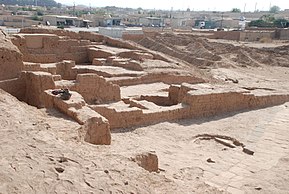Tell Halaf
| تل حلف | |

Part of the excavated ruins of Tell Halaf
|
|
| Location | Al-Hasakah Governorate, Syria |
|---|---|
| Coordinates | 36°49′36″N 40°02′23″E / 36.8266°N 40.0396°E |
| Type | settlement |
| History | |
| Founded | ca. 6,100 BCE |
| Abandoned | ca. 5,400 BCE |
| Periods | Neolithic |
| Cultures | Halaf culture |
| Site notes | |
| Excavation dates | 1911—1913, 1929 2006—present |
| Archaeologists |
Max von Oppenheim Lutz Martin Abd al-Masih Bagdo |
| Ownership | Public |
| Public access | Yes |
Tell Halaf (Arabic: تل حلف) is an archaeological site in the Al Hasakah governorate of northeastern Syria, near the Turkish border, just opposite Ceylanpınar. It was the first find of a Neolithic culture, subsequently dubbed the Halaf culture, characterized by glazed pottery painted with geometric and animal designs. The site dates to the 6th millennium BCE which was a Hittite ruling city at first and was later the location of the Aramaean city-state of Guzana or Gozan in the 10th century BCE. By the end of 9th century BCE the city and its surrounding area was incorporated into the Assyrian Empire. During the Syrian Civil War, People's Protection Units took control of the area.
The site is located near the city of Ra's al-'Ayn in the fertile valley of the Khabur River (Nahr al-Khabur), close to the modern border with Turkey. The name Tell Halaf is a local Aramaic placename, tell meaning "hill", and Tell Halaf meaning "made of former city"; what its original inhabitants called their settlement is not known.
In 1899, when the area was part of the Ottoman Empire, Max von Oppenheim, a German diplomat travelled through northern Mesopotamia on behalf of Deutsche Bank, working on establishing a route for the Bagdad Railway. On 19 November, he discovered Tell Halaf, following up on tales told to him by local villagers of stone idols buried beneath the sand. Within three days, several significant pieces of statuary were uncovered, including the so-called "Sitting Goddess". A test pit uncovered the entrance to the "Western Palace". Since he had no legal permit to excavate, Oppenheim had the statues he found reburied and moved on.
...
Wikipedia

